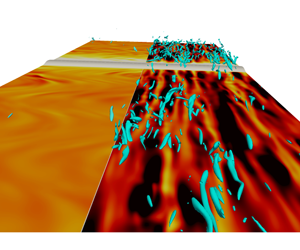Crossref Citations
This article has been cited by the following publications. This list is generated based on data provided by
Crossref.
Mele, Benedetto
Tognaccini, Renato
Catalano, Pietro
and
de Rosa, Donato
2020.
Effect of body shape on riblets performance.
Physical Review Fluids,
Vol. 5,
Issue. 12,
Albers, Marian
Meinke, Matthias
and
Schröder, Wolfgang
2021.
High Performance Computing in Science and Engineering '20.
p.
281.
Nguyen, Vinh-Tan
Ricco, Pierre
and
Pironti, Gianluca
2021.
Separation drag reduction through a spanwise oscillating pressure gradient.
Journal of Fluid Mechanics,
Vol. 912,
Issue. ,
Nasr, Ahmed
Yang, Fan
Zhang, Yiqi
Wang, Tieli
and
Hassan, Mahmoud
2021.
Analysis of the Flow Pattern and Flow Rectification Measures of the Side-Intake Forebay in a Multi-Unit Pumping Station.
Water,
Vol. 13,
Issue. 15,
p.
2025.
Mele, Benedetto
2022.
Riblet Drag Reduction Modeling and Simulation.
Fluids,
Vol. 7,
Issue. 7,
p.
249.
Luchini, Paolo
and
Quadrio, Maurizio
2022.
50+ Years of AIMETA.
p.
349.
Quadrio, Maurizio
Chiarini, Alessandro
Banchetti, Jacopo
Gatti, Davide
Memmolo, Antonio
and
Pirozzoli, Sergio
2022.
Drag reduction on a transonic airfoil.
Journal of Fluid Mechanics,
Vol. 942,
Issue. ,
Ceccacci, Silvia
Calabretto, Sophie A.W.
Thomas, Christian
and
Denier, James P.
2022.
The effect of slip on the development of flow separation due to a bump in a channel.
Journal of Fluid Mechanics,
Vol. 951,
Issue. ,
Cacciatori, Lorenzo
Brignoli, Carlo
Mele, Benedetto
Gattere, Federica
Monti, Celeste
and
Quadrio, Maurizio
2022.
Drag Reduction by Riblets on a Commercial UAV.
Applied Sciences,
Vol. 12,
Issue. 10,
p.
5070.
Gallorini, Emanuele
Quadrio, Maurizio
and
Gatti, Davide
2022.
Coherent near-wall structures and drag reduction by spanwise forcing.
Physical Review Fluids,
Vol. 7,
Issue. 11,
Selvatici, Davide
Quadrio, Maurizio
and
Chiarini, Alessandro
2023.
Curvature effects on the structure of near-wall turbulence.
Journal of Fluid Mechanics,
Vol. 972,
Issue. ,
Massaro, Daniele
Martinelli, Fulvio
Schmid, Peter
and
Quadrio, Maurizio
2023.
Linear stability of Poiseuille flow over a steady spanwise Stokes layer.
Physical Review Fluids,
Vol. 8,
Issue. 10,
Mele, Benedetto
Saetta, Ettore
and
Tognaccini, Renato
2023.
Analysis of riblets modeling for aeronautical applications.
Nozarian, Sina
Abkar, Mahdi
and
Forooghi, Pourya
2024.
An analysis of drag reduction using spanwise forcing on rough walls.
International Journal of Heat and Fluid Flow,
Vol. 106,
Issue. ,
p.
109306.
Gallorini, Emanuele
and
Quadrio, Maurizio
2024.
Spatial discretization effects in spanwise forcing for turbulent drag reduction.
Journal of Fluid Mechanics,
Vol. 982,
Issue. ,
Gattere, Federica
Zanolini, Massimo
Gatti, Davide
Bernardini, Matteo
and
Quadrio, Maurizio
2024.
Turbulent drag reduction with streamwise-travelling waves in the compressible regime.
Journal of Fluid Mechanics,
Vol. 987,
Issue. ,
Xi, Lingchu
Quadrio, Maurizio
and
Zhou, Yu
2024.
Fluid-Structure-Sound Interactions and Control.
p.
85.
Zhang, Lu
Lv, Mengfei
Zhao, Xiaoxue
Fan, Haoyang
Xie, Zhijie
and
Li, Kai
2024.
Arrangement and Control Parameter Selection Methods of Piezoelectric Traveling Wave Drag Reducer.
IEEE Transactions on Industrial Electronics,
Vol. 71,
Issue. 12,
p.
16264.
Zhang, Lu
Lv, Mengfei
Zhao, Xiaoxue
Fan, Haoyang
Xie, Tao
Shan, Xiaobiao
and
Li, Kai
2024.
Achieving travelling wave drag reduction by micro piezoelectric actuator.
International Journal of Mechanical Sciences,
Vol. 275,
Issue. ,
p.
109326.
Ceccacci, Silvia
Calabretto, Sophie A. W.
Thomas, Christian
and
Denier, James P.
2024.
Dynamics and control of separated flow over small-scale surface deformations with slip.
Physical Review Fluids,
Vol. 9,
Issue. 3,
